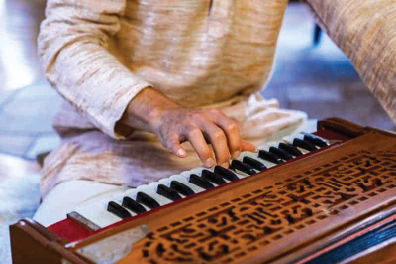
Article by
What comes to mind when you imagine harmonium? Mehdi Hasan humming one of his mesmerizing ghazals, singing a melodious Qawwal, or a classical singer enthralls the atmosphere with his energetic voice. This instrument has become associated with Indian music in such a way that it is difficult to imagine classical music and ghazal singing without it. But it may come as a surprise to many that the harmonium is not an Indian or 'indigenous' instrument at all, but an import from the West like the piano, violin and guitar. It is a different thing that despite being a foreigner, this instrument flourished in the subcontinent to such an extent that it remained a part of this land.
In Europe, the organ was widely used in religious music played in churches, but the problem was that the instrument was too large and too expensive for small churches to afford. To find a solution to this problem, various 'instrumentalists' in different countries of Europe were trying to make small and 'portable' organs. Finally, in 1840, a French inventor, Alexandre Dubin, succeeded in inventing such an instrument and named it harmonium. The instrument was cheap, easy to teach and play, and relatively small, so it could be picked up and carried anywhere. On the basis of these qualities, it quickly spread throughout Europe and from there to America, and in addition to institutions, ordinary people also started buying it for home use. Europe's top composers composed music specifically for the instrument, with the names of the great composers Dvorak, Mahler and Shostakovich leading the list. Wherever the English people spread, they took the harmonium with them, like English, cricket and tea. Among these colonies was India, where this instrument arrived in 1868, exactly one and a half hundred years ago today.
Bengali musician Dwarkanath Ghosh liked this instrument and made some changes to bring it closer to the Indian mood. Soon the company he founded, Dwarkan & Son, began to manufacture and sell the instrument on a commercial basis. One of the innovations he made in it was that its bellows were played by hand instead of foot, thus reducing the volume of the instrument to half. This is the same harmonium that you might have seen Ustad Amanat Ali Khan and Mehdi Hasan playing. At first, the musicians of India looked at this foreign instrument with suspicious eyes. But gradually it started getting acceptance. Before the harmonium, sarangi was used for accompaniment in classical music. Sarangi is a very beautiful instrument but one problem is that for each raga its heads have to be tuned separately which sometimes takes a lot of time. On the other hand, it cannot be denied that sarangi is very difficult and it takes ages to perfect it. This is why it is not easy to find a good manufacturer. Harmonium, on the other hand, had no such difficulty, any man or woman can make him or herself master of harmonium after a few months of practice. Just play it, it will play.
As a result, the instrument soon took root in India and was not only played here but also manufactured on an industrial scale. By 1915, India had become the largest harmonium producer in the world. After Bengal, harmonium was embraced by Marathi theatre, then by Parsi theatre. Apart from the advantages mentioned above, one of his advantages was that despite being small, his booming voice easily covered the entire venue. Harmonium is a very popular instrument of the subcontinent and is widely used in ghazal singing and Qawwali.
 Monthly "Azeem English Magazine", launched in 2000, records the information about diverse fields like mental health, literature, research, science, and art. The magazine's objective is to impart social, cultural, and literary values to society.
Monthly "Azeem English Magazine", launched in 2000, records the information about diverse fields like mental health, literature, research, science, and art. The magazine's objective is to impart social, cultural, and literary values to society.
+92 51 88 93 092
First Floor, RAS Arcade, Eidhi Market, Street#124, G-13/4, Islamabad, Pakistan, 44000.